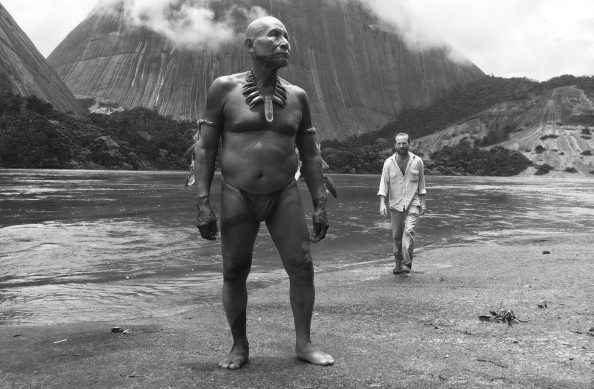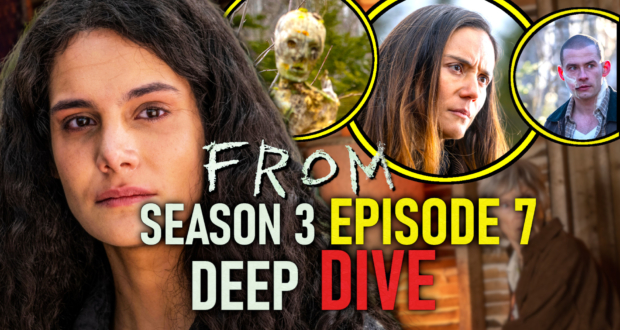https://www.youtube.com/watch?v=2-e_20IOM3I
Synopsis: The story of the relationship between Karamakate, an Amazonian shaman and last survivor of his people, and two scientists who work together over the course of 40 years to search the Amazon for a sacred healing plant.
Ciro Guerra’s Embrace of the Serpent tells two stories, happening forty years apart, both involving an Amazonian shaman by the name of Karamakate. The young, athletic, and sophomoric Karamakate (Nilbio Torres) meets a scientist in the jungle who has fallen ill, and needs the curing powers of a sacred plant to heal him. Karamakate braves the jungle with the scientist in tow to find the cure. An older, wryer, and funnier Karamakate (Antonio Bolivar) meets a different scientist four decades later, this one not sick and with far less personality, but also in search of the same mystical plant. Will Karamakate help them both find the silly fake plant that has dumb healing powers? Can two actors handle the mighty task of playing Karamakate? Is this just a black-and-white, low-key version of Avatar? Let’s just say, unfortunately, you’ll have to watch it to find out.
THE GOOD:
Karamakate may not be the most congruous character from his youthful version to his older self, but both forms are entertaining. The younger Karamakate comes off as a purely unaffected bro—like when he cannot contain his laughter at the discovery of the effeminately worded love letter the scientist has written to his wife. But we don’t just laugh at Karamakate’s juvenility, we laugh with him, because he’s charming in his insolence, and that’s the truest test of a bro’s likability. Torres’ passionate portrayal of the young Karamakate is equal parts exuberance and rage. His emotional outbursts help us to respect his passion, even if we wince at his rough edges. His boyish good looks and impressive physique are shown off in a nearly fetishized fashion, though it does wonders for his appeal. I just couldn’t pull my gaze away from his bod.
The older Karamakate, played by a cue-ball-bald and paunchy Antonio Bolivar, is not necessarily the most believable end product of the maturation of young Karamakate, but he’s so snarky and witty, it’s hard not to be twisted by his sly tongue. The actors each clearly embrace the archetype they embody, and Karamakate is perhaps the thinnest character I’ve seen in a while that was still decidedly enjoyable to be around.

THE BAD:
One unfortunate camera movement announced exactly what kind of film Embrace would end up being. With the camera set behind (older) Karamakate, cinematographer David Gallego abandons any type of restraint to allow the audience the opportunity for discovery. Instead of being able to investigate the shot on our terms, an unfortunate zoom-in gets nice and tight to what we’re “supposed” to see. This is a small example of the larger problem of Embrace. Too much is spelled out, over-explained, and repeated. The message is important (I guess), but lost upon us, our poor heads hurting from the relentless hammering in of Guerra’s themes and ideas.
There is a dedication during the closing credits—Embrace is made for the native people of the Amazon, whose stories have been lost to the passing of time. But here their story appears shallow, and resembles the flat, condescending sensitivity of an Avatar (the plot also revolves around the destruction of the jungle for the benefit of the rubber manufacturing industry, furthering the Avatar connection, and Fern Gully, too, while we’re at it). One overriding theme is the abusive relationship between white, civilized explorers (in this case hailing from Colombia) and the native people whom they find, befriend, and abuse along their travels. But like any well-intentioned, conscious person is susceptible to do, Guerra is almost too respectful of his subject matter to be at ease with it and with us. There is little fun with Embrace that isn’t already sanctioned, like a labored joke told by an unfunny relative. But here there is no pressure to laugh along out of politeness. I have all the time in the world to hear of the struggles of any group of people affected by the imperialism of white devils. But what is a film for, if not first to entertain, and to speak up second? Embrace is a tiring experience, because its raison d’etre is cinematic speechifying, and that just plain sucks to watch when the rest of the movie isn’t up to snuff. I think part of why Spike Lee’s Chi-Raq has been so divisive is because while he, too, is speechifying to the nth degree, the movie itself is so entertaining (if only by dint of its truly bizarre construction) that it demands to be heard and dissected despite its shortcomings. That’s a brazen, brave film, regardless of its politics or anything else about it. This one comes up short on what is essential to any moviegoer—is it keeping my attention long enough to have any kind of effect?
No matter how much I found to be laboring and thin, what I couldn’t stop asking myself was why this movie was shot in black-and-white. What purpose did it serve? Where was it drawing inspiration? In fact, why does any film shoot in black-and-white anymore? It seems like a dirty trick, something “artistic” and “timeless,” except only few films can achieve such artistry and timelessness. Was it to better service the climax, a trippy scene of a drug-induced euphoria that reminded me of all the bad things about Kubrick’s influence? The short, explosive burst of color was about as vibrant as faded tie-dye, and about as cool, too (though, to be honest, I love tie-dye). And I found it just as strained an effort as the rest of the film. The few lively scenes—centering on the negative influence of Christianity on the natives, there’s a couple of contrived scenes that at least pick up the tempo—likely exist to distract us from the stereotypical episodes, and the uninspired dialogue. Through the many scenes of wandering the jungle, of debating ideology, the intentions are so obvious it upends our ability to really consider what we’re witnessing. Like, maybe indigenous cultures deserve more than a story of their experience in relation to whitey, or of mystical plants and medicines with side effects like tripping out. Maybe we don’t even need a white guy around to better understand the plight, or even just the day-to-day existence, of a person living in the Amazonian jungles a thousand years ago. History books do a decent job of explaining the past. Movies sometimes should avoid cramming a transparently aimed history lesson into their short lifespan, and maybe just focus on giving their subject as much honest-to-goodness life on the screen as possible.

THE VERDICT:
I applaud Guerra for having the heart to tell a story for people who didn’t get a chance to tell it themselves, but I deride his lack of creativity. There are many opportunities to enjoy Guerra’s style–a couple of meditative shots involving animals, notably an anaconda, are welcomed, along with a series of wide angled shots showing off the beauties of the location. I’m not angry at the simplicity, merely disappointed. See this movie if you need a refresher on the surface evils of imperialism, or if you just love serpents. But don’t say I didn’t try to poop on your party.
-
Acting - 7/10
7/10
-
Cinematography - 6.5/10
6.5/10
-
Plot/Screenplay - 4/10
4/10
-
Setting/Theme - 4.5/10
4.5/10
-
Buyability - 4/10
4/10
-
Recyclability - 1/10
1/10




















